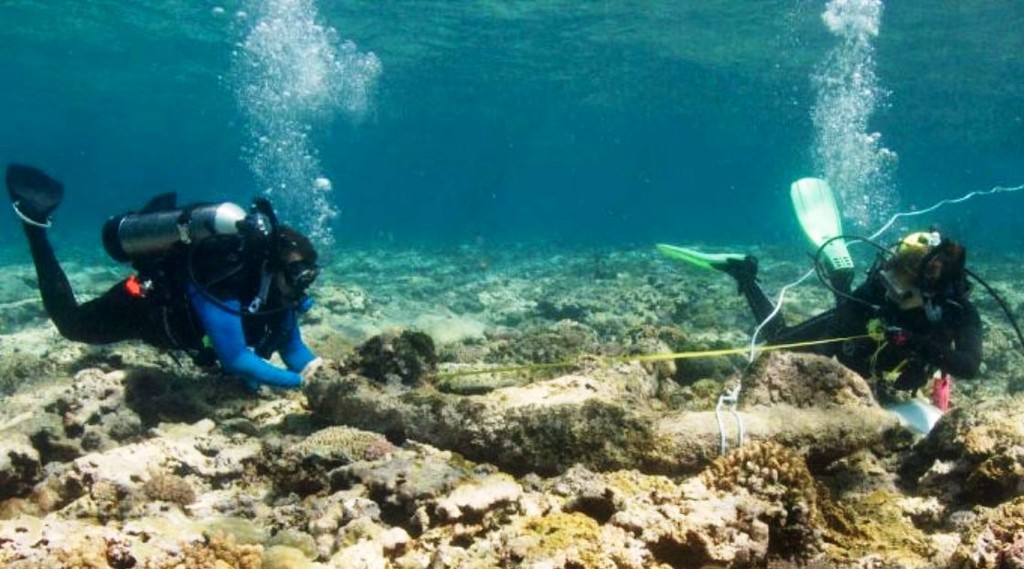Tasmanian Shipwrecks
by Carl Hyland on 8 May 2012

Shipwreck diving can be a fascinating experience. Carl Hyland
As an island colony and later state of the Commonwealth of Australia, Tasmania has always been fundamentally dependent on shipping services to connect it to the outside world. However, lying in the path of the winds known as the 'roaring forties', the waters around Tasmania have proved treacherous to mariners. Since the wreck of the ship Sydney Cove in 1797, around 1,000 vessels of all sizes are known to have been lost in Tasmanian waters up to the present day.
Although the locations of less than 10% of these shipwrecks are presently known these sites are important parts of our national maritime heritage, a unique gift from our past. While many shipwrecks can only be visited by suitably qualified divers material may also be seen on the sea shore or in tidal zones. Many shipwreck sites are often left unlocated or undisturbed for years and some natural processes of decay and decomposition are stopped or substantially slowed in the underwater environment. For these reasons shipwreck sites are time capsules which can open a window into history.
Two laws protect the remains of shipwrecks in Tasmanian waters. The Commonwealth Historic Shipwrecks Act 1976 applies to Australian Commonwealth waters extending from the low water mark to the outer edge of the continental shelf. The State Historic Cultural Heritage Act 1995 applies to shipwrecks that lie within the state waters of Tasmania (harbours, enclosed bays, estuaries, rivers and lakes).
Under both these Acts all shipwrecks and their associated artefacts which were lost over 75 years ago are automatically protected. Shipwrecks that occurred less than 75 years ago may also be individually protected under these Acts if they are considered to be significant. In special circumstances when a shipwreck is considered highly significant or vulnerable a 'Protected Zone' may be declared around the site, requiring a permit from the management authority to enter. There are currently no 'Protected Zones' in Tasmania.
In all instances members of the public are welcome to visit shipwrecks provided they do not collect artefacts or otherwise disturb or damage the sites. Underwater sites are often quite delicate and even apparently small disturbances can result in considerable long term damage. Under the current laws it is illegal to interfere with a protected shipwreck site without a permit from the managing authority.
Both laws require discoveries of a shipwreck or the possession of artefacts from protected shipwrecks to be reported.
Listed are eleven shipwrecks that have occurred in Tasmanian waters during the last two hundred years:
Sydney Cove
Cataraqui
Litherland
Brahmin
Cambridgeshire
Bulli
Tasman
Svenor
Nord
Otago
Alert
Of course, the most recent shipwreck to occur was the Iron Baron which ran aground on Hebe Reef at the mouth of the Tamar on 10th July 1995.
The Iron Baron, a 37,557 dwt BHP chartered bulk carrier (built in 1985) grounded on Hebe Reef at the approach to the Tamar River, northern Tasmania at 1930 hours (7.30pm) Eastern Standard Time (EST) on Monday 10 July 1995. The vessel had departed from the NSW port of Port Kembla on Saturday 8 July 1995, with a 24,000 tonne cargo of manganese ore that had been loaded at Groote Island, bound for the BHP owned TEMCO facility at Bell Bay which is located some 12 km inside the Tamar River estuary and within the port of Launceston. Weather conditions prevailing at the time were north westerly winds of 20-25 knots with two metre seas.
Shortly after the grounding, it was confirmed bunker fuel oil had escaped, which was later estimated at around 300 tonnes. The ship's crew were safely evacuated, whilst National Plan response arrangements were initiated. Weather conditions deteriorated and with the prevailing tidal conditions, oil impacted shorelines in the vicinity of Low Head. There was significant impact on wildlife, particularly little penguins.
Whilst work continued to refloat the casualty, clean up of affected shorelines was underway. A large wildlife collection, treatment and rehabilitation program was established at the pilot station complex at Low Head, north of George Town.
The ship was refloated on Sunday 16 July 1995, and the vessel moved to an anchorage, some two miles offshore. The Port of Launceston Authority imposed a number of conditions to be met in relation to port safety and environmental protection, before the vessel could enter port.
There was further oil released from under the ship following the refloating, some of which was successfully collected at sea whilst some impacted Bakers Beach and the Rubicon River estuary in the vicinity of Port Sorell. Several Bass Strait near shore islands were impacted at some locations. These islands were also the scene for a concentrated wildlife collection effort.
Underwater inspections and onboard assessments confirmed major structural damage had occurred and with the ship's condition reported to be deteriorating, and adverse weather predicted, BHP as the ship owner, decided to dump the vessel. The Commonwealth Environment Protection Agency approved a disposal site some 53 miles east of Flinders Island. After towing to the dumping area, the Iron Baron sank around 1930 hours (7.30pm), Sunday 30 July 1995.
Most losses around the Tasmanian coast have been smaller vessels that have been blown ashore while sheltering from heavy weather, or grounded attempting to negotiate the exposed entrances to ports around the coast. In more recent years most accidents, whether they be to small yachts or fishing vessels, or large interstate steamers and motor ships, can still generally be put down to navigational and control errors of one type or another. The most spectacular of these was the bulk carrier Lake Illawarra's collision with Hobart's Tasman Bridge in 1975, resulting in the loss of the ship and twelve lives, and uncounted expense and inconvenience to the unexpectedly divided city. Others have come as the result of stress of weather, especially in Bass Historic Australian Shipwrecks website
If you want to link to this article then please use this URL: www.sail-world.com/96949